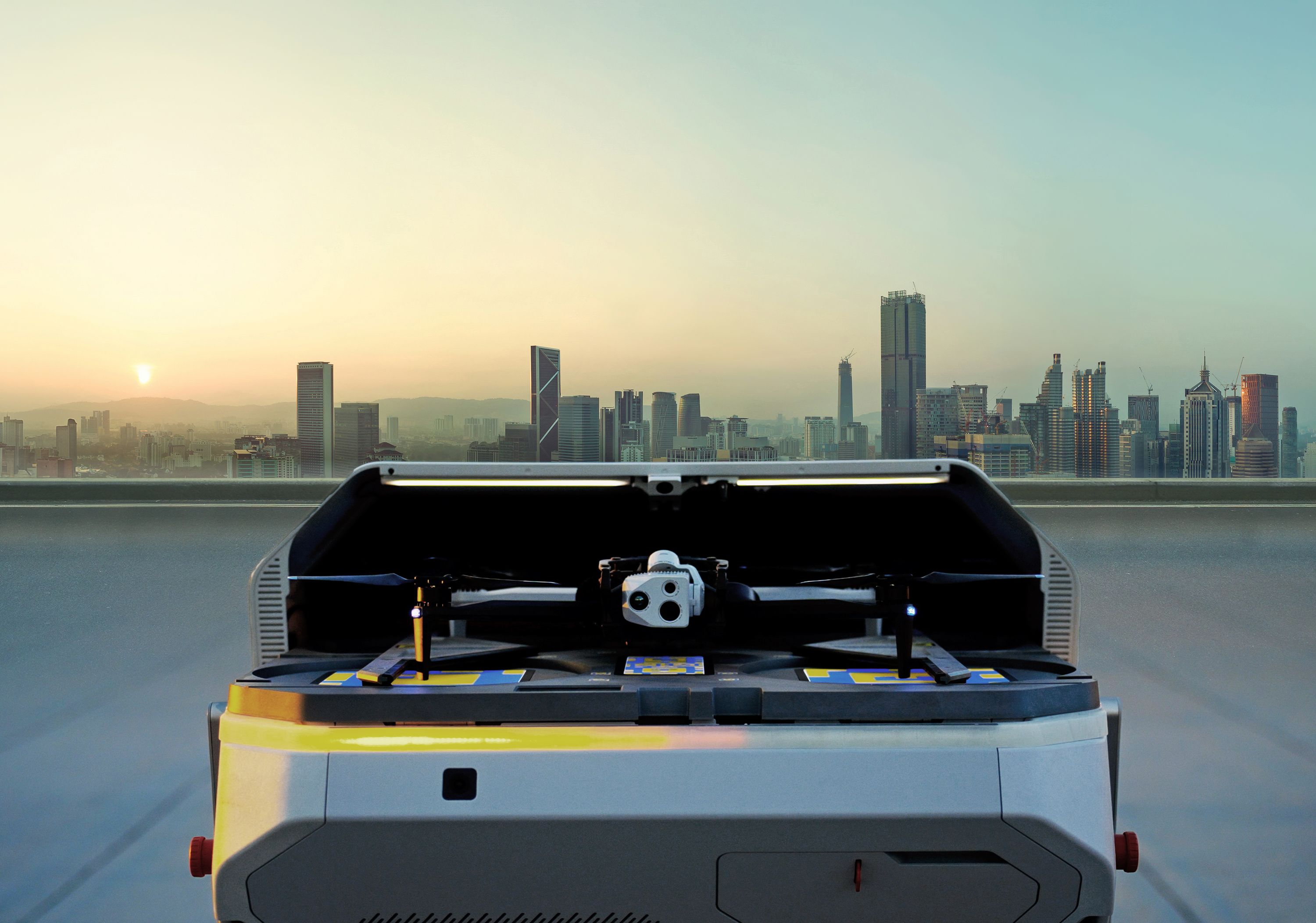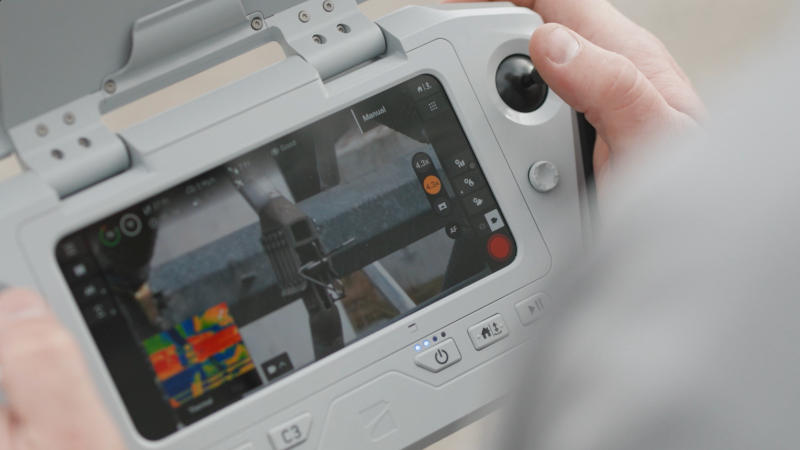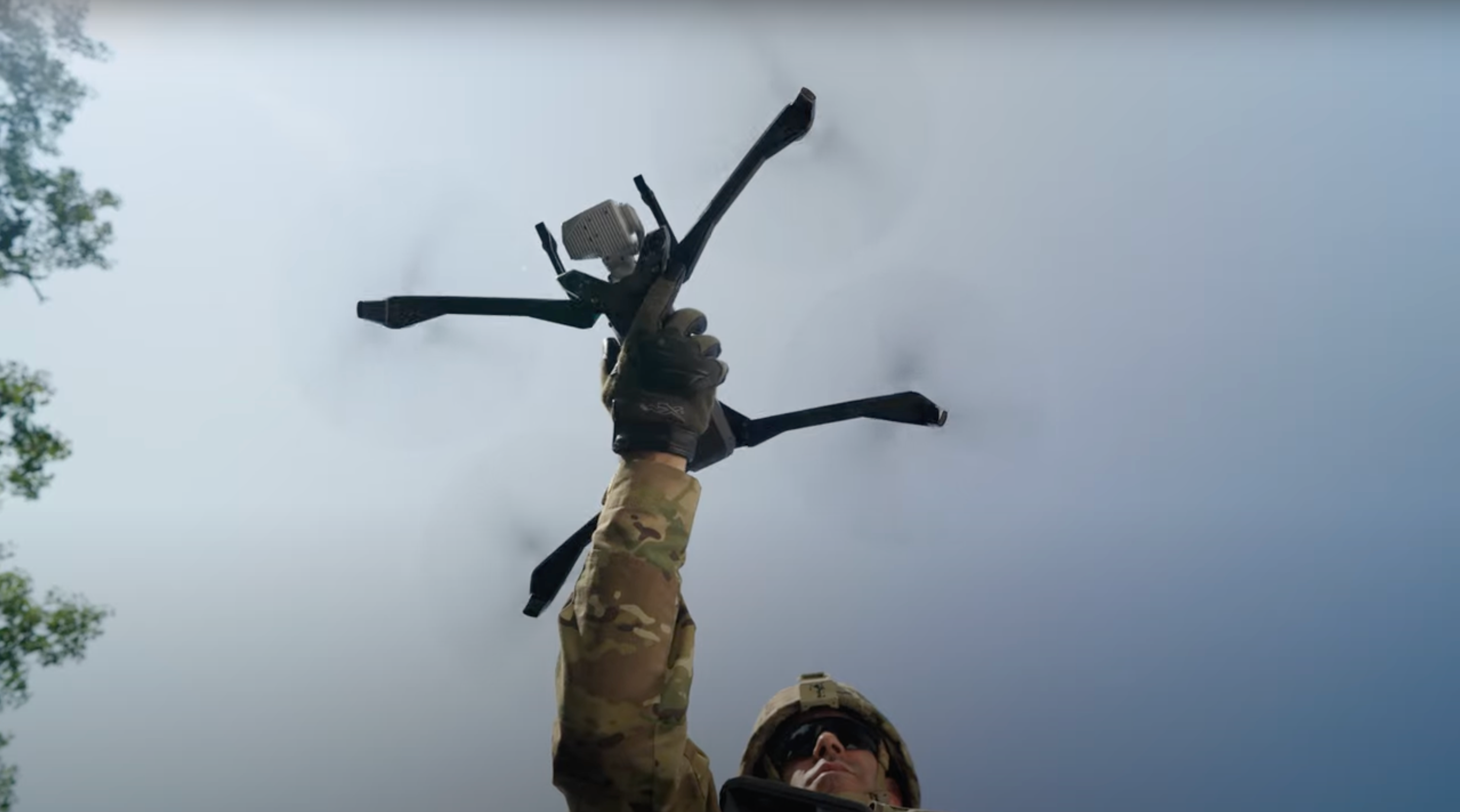FAQs about Dock for X10
This docking station is much more than simply a place to charge and shelter your drone. It’s part of an integrated system designed to enable reliable, scalable, fully autonomous remote drone operations. Check these FAQs to gain a better understanding of what’s possible and how this could serve your organization.
About Dock
What is a drone docking station or drone-in-a-box?
A drone docking station — which some have previously called a drone-in-a-box — is an autonomous launch, landing, charging, and data sync station for drones. It allows you to deploy drones remotely without needing a pilot on-site.
The Skydio Dock for X10 protects the drone from weather, keeps it charged, and connects it to cloud or command center systems. With software like Skydio Remote Ops or DFR Command, drones can be launched, flown, and managed from anywhere, enabling fully remote operations.
What capabilities are important in a drone docking station?
While all docks support basic tasks like charging and sheltering the drone, the best systems are designed to enable reliable, scalable, and fully autonomous operations — especially in all environments.
Rugged reliability
A docking station should enable reliable autonomous launch and landing, day or night, in wind, rain, or snow. Skydio Dock for X10 is rated IP56 and engineered to remain operational in harsh environments, including hurricane-force winds when properly bolted down.
Purpose-built operational software
To remotely operate docked drones, you need software that can launch, control, monitor, and manage missions — often across multiple locations. The right software also integrates with the tools you use daily such as dispatch systems, photogrammetry tools, and evidence management solutions and more.
Skydio Remote Ops and DFR Command platforms are designed specifically for these tasks, offering browser-based control, automated workflows, livestreaming, and full program oversight. Both support open APIs and ICDs so you can integrate with your existing systems.
Reliable Connectivity
Fly where the mission demands without worrying about losing connection. Reliable connectivity enables longer-range flights, higher-quality livestreaming, and low-altitude operations in places where traditional radios struggle, like urban canyons, dense infrastructure, or complex terrain.
Each Dock for X10 includes a Skydio Connect External Radio for high-performance, point-to-point communication with the drone. This works in tandem with the 5G connectivity built into the X10, using a technology called Skydio Connect Fusion. Fusion continuously monitors available connections and automatically switches to the strongest signal — whether that's radio or 5G.
The result is uninterrupted control, smooth video streaming, and resilient performance, even in the most challenging environments.
Rapid response
When it’s time to fly a mission, you want to ensure your drones can get out of the Dock and start working quickly. Skydio Dock for X10 uses an automated pre-flight sequence to get your drone airborne in 20 seconds.
Beyond Visual Line of Sight (BVLOS) readiness
For remote flight (autonomous or piloted), you must adhere to FAA regulations and secure appropriate waivers. Skydio Dock for X10 is designed to help you operate in compliance with waiver requirements, with features including:
- An Automatic Dependent Surveillance - Broadcast (ADS-B) receiver for airspace awareness
- Integrated weather sensors and Dock cameras for preflight checks
- Automatic contingency behaviors to respond to off-nominal situations, such as pre-programmed emergency landing zones.
- Remote ID for pilots
The Skydio Regulatory Team has deep experience working with customers to document and navigate the FAA waiver process for BVLOS and other advanced operations.
How do organizations use the Dock for X10 in my industry?
Use cases include:
- Public Safety: Drone as First Responder (DFR), situational awareness, evidence collection
- Utilities & Critical Infrastructure: Routine inspections, patrols, thermal inspections
- Defense & National Security: Base perimeter monitoring, force protection
- Transportation & Construction: infrastructure inspection, progress monitoring
What is a “hive” and why would I need one?
A hive is a group of 2–6 Docks deployed together at a single site. By operating as a coordinated system, a hive enables capabilities that a single Dock alone can’t:
- Persistent coverage: As one drone’s battery depletes, it remains on station until a replacement drone launches and arrives to take its place, ensuring seamless, uninterrupted 24/7 coverage.
- Multi-mission response: Multiple drones can be tasked simultaneously to respond to different alerts or areas of interest, improving your ability to cover more ground, faster.
- Redundancy and resilience: If one Dock is unavailable, others can continue the mission.
- Multi-angle visibility: Hives make it possible to capture a scene from different perspectives in real time, ideal for large incidents or complex infrastructure.
Skydio Remote Ops and DFR Command manage hives with smart channel allocation, flight coordination and automated airspace deconfliction, ensuring drones operate safely.
How many Docks can I operate at once?
There’s no software limit to how many Docks you can monitor through Skydio Remote Ops or DFR Command. A single operator can oversee multiple Docks and view video feeds across sites from a centralized dashboard.
Current FAA regulations permit a remote pilot to actively control only one drone at a time. That said, pilots can manage handoffs, monitor readiness, and prepare missions across multiple Docks in parallel.
Skydio is building for the future — multi-drone operations will be fully supported as regulations evolve and waivers are granted. The platform is designed to scale with your program as airspace rules are expanded.
Does Dock have the ability to monitor the weather?
Yes. Remote pilots are required to know local conditions before initiating a flight, and the Dock for X10 is equipped to provide that visibility.
Each Dock includes an integrated weather sensing system that monitors temperature, wind speed, and precipitation at the launch site. These readings are displayed in Skydio Remote Ops or DFR Command, helping pilots make informed, compliant go/no-go decisions for every mission.
This capability is especially valuable for BVLOS operations, where on-the-ground situational awareness is essential for safe remote flight.
Can the Dock be set up and operated in remote locations?
Yes. Dock for X10 can operate in remote areas as long as it has power and network connectivity. Connectivity can be provided by cellular backhaul (5G/LTE) or Starlink satellite internet, and the dock can be powered by a generator or solar-backed battery systems, assuming they meet the required voltage and power draw.
Technical specs
What kind of internet connection is required at the Dock site?
The Dock requires a minimum upload speed of 20 Mbps, though 100 Mbps is recommended for high-performance media sync. Connectivity can be provided via local network (Cat6 to the dock), Starlink, or 5G backhaul depending on your deployment model.
How long does it take to recharge a battery from the Dock?
Charging from 15% to 95% takes approximately 35 minutes at 25°C. In extreme temperatures, the charge time may extend to a maximum of 73 minutes due to heating or cooling.
Can the Dock for X10 withstand harsh environments?
Yes. It operates in temperatures from -20°C to 50°C (-4°F to 122°F), resists dust and rain (IP56 closed), and withstands winds up to 160 km/h (100 mph) when bolted.
Can the Dock operate (launch a drone) in poor weather conditions?
Yes. The Dock is designed to support autonomous flight in light rain/snow, and at night, thanks to environmental sensors, ADS-B, and Skydio NightSense.
What is the size of Dock, and how much does it weigh?
Fully assembled, the Dock weighs ~229 lbs and measures roughly 55.5" x 34.1" x 47.8". It's comprised of three modular components: roof, core, and stand.
What are the power requirements and backup options for the Dock?
Dock for X10 requires 100–240V AC input, but 220V is recommended for operation below 0°C. In extreme cold or heat, the dock uses internal HVAC to maintain operational temperature.
What safety features are built into the Dock for X10?
The dock includes physical and software-based safety systems designed for safe operation in any environment.
- Emergency Stop (E-Stop) for immediate halt of operations
- Surround lighting for visibility and signaling
- Audible alerts to warn nearby personnel
- Remote preflight checks using an integrated camera
- Safe landing zones for automated emergency landings
These systems enhance operational safety for both operators and bystanders, especially in environments like rooftops, substations, or busy urban areas.
Deployment, training and maintenance
What’s involved in deploying a Dock for X10?
Dock deployment is designed to be fast, safe, and repeatable — even in remote or rugged environments. Each deployment follows a structured process:
Site Assessment
Before installation, Skydio conducts a Pre-Site Survey to evaluate power availability, network connectivity, line-of-sight, mounting surface, and environmental exposure. This ensures your location is optimized for reliable operations.
Site Readiness
Based on the guidance from the site survey, it’s the customer’s responsibility to ensure each deployment location is ready before the installation team arrives with the proper:
- Power: 100–240V AC input (220V recommended for cold weather operations)
- Networking: Minimum 20 Mbps upload (100 Mbps preferred). Cat6 connection run to the dock with 1" conduit
- Clearance: Minimum 12 ft from obstacles and 6 ft between Docks; surface must be level within ±3°
- Mounting: Can be bolted down for high-wind environments or placed freestanding with leveling feet
Deployment Logistics
- Each Dock for X10 arrives in modular components and can be transported by people, forklift or crane.
- Installation typically takes 1-3 days, including hardware assembly, connectivity checks and testing
- A Skydio field technician is on-site for setup, testing, and onboarding
Training and Readiness
Deployment includes two days of on-site training, covering mission planning, fleet management, and operational best practices. Your dock is then ready for autonomous missions within your secure network or over cellular backhaul.
Ongoing Support
Post-deployment, your dock is fully supported under the included Maintenance and Repair Plan, with remote monitoring, updates, and field service included throughout its operational life.
Can the Dock be moved or reinstalled?
Yes. Dock for X10 has a modular design and can be disassembled into two major components (body and stand) for transport. It is engineered to tolerate transport no more than once per month over its service life.
How is the Dock maintained?
Dock for X10 is built for reliability and long-term service, with a projected lifespan of five years under regular use. Maintenance includes:
- Customer-replaceable items like props and light cleaning
- Minor service every 3 months (e.g., inspection, diagnostics, filters)
- Major service every 2 years (e.g., part replacement, full inspection)
- Remote health monitoring via Skydio Cloud, which alerts users to upcoming service needs
Each Dock is sold with a Maintenance and Repair Plan that covers all scheduled servicing, parts, and repair needs for its entire operational life—ensuring maximum uptime without surprise costs.
Flight software
How do I fly Dock-based drones?
Operators can pilot Dock-based X10s over Remote Flight Deck (RFD), our browser-based software. Remote Flight Deck is part of two Skydio web software packages:
- Remote Ops – Useful for off-site inspections, monitoring, and mission coordination. Learn more at skydio.com/software/remote-ops
- DFR Command – Designed for public safety agencies, DFR Command allows dispatchers or command staff to task drones to incident scenes, stream live video, view street overlays, and coordinate with responding units. Learn more at skydio.com/software/dfr-command
What kind of software capabilities are needed for remote Dock operations?
To run a Dock-based drone program effectively, your software needs to do more than just fly the drone—it should manage your entire operation from launch to maintenance. Skydio Remote Ops and DFR Command, both with embedded Remote Flight Deck, provide a comprehensive software stack designed for that purpose.
Fly drones remotely— manually or autonomously
- Launch and control drones directly from your browser using “Fly Now” or “Fly to Point”
- Automatically dispatch drones based on integrations with alarms, sensors, or scheduling systems
- Run routine patrols, inspections, or mapping missions using pre-defined, repeatable autonomous workflows
Enhance flight control and situational awareness
- Use Fly-to-Point with GPS coordinates, CAD calls, or map clicks to intelligently route drones
- Activate Free Look to pan the camera while the drone flies autonomously—ideal for searching large areas or scanning incident scenes
- Overlay mission-critical data with augmented reality (AR): street overlays, addresses, features directly in your flight view
- Operate onboard attachments like speaker, spotlight, and parachute directly from the interface
- Define geofences, keep-out zones, and safe landing areas using layered maps to fly with full context
- Choose your preferred piloting interface: Double Click to Fly, Game Pad, Keyboard, or Pointer Lock
Livestream and collaborate in real time
- Share drone video instantly via ReadyLink. View feeds from connected platforms such as Fusus directly from your phone/laptop.
- Set up streams in advance for scheduled events or on the fly for incident response.
Manage post-flight reporting
- Automatically upload flight to photogrammetry, evidence management systems, and other third-party tools with Skydio extent integrations
- Detailed reports allow you to analyze data on flights, pilots, docks, drones, devices, and more
- Post to your Skydio Transparency Dashboard for stakeholder or community access
Post-flight data management
- Automatically sync media and telemetry to evidence management, photogrammetry, or enterprise systems using Skydio Extend.
- View detailed reports on pilots, drones, flights, Docks, and devices.Share selected flight data with your community via the Skydio Transparency Dashboard
IT security and system integration
- Use Single Sign-On (SSO) with Okta, Axon, and other enterprise providers
- Access a growing catalog of native integrations and open APIs/ICDs. Skydio offers professional services for custom workflows
- Stay secure with SOC 2 Type II and CJIS certification and regular updates
- Deploy your setup across single or multiple screens—ideal for command centers
Operational management
- Get full visibility into your fleet’s status and readiness
- Inspect aircraft remotely using Dock-mounted cameras
- Monitor usage, get health alerts, and track service history through the Remote Ops dashboard
- Enable condition-based maintenance to extend the life of your drones and Docks while minimizing downtime
Where can I find a full list of Skydio integrations?
Skydio integrations are powered by Skydio Extend, a platform included with both Remote Ops and DFR Command. Extend connects your drone workflows to the systems you already use, like dispatch software, SCADA, CAD, photogrammetry tools, digital evidence platforms, and more. With Extend, you can:
- Trigger flights automatically from alerts or scheduling systems
- Stream video into platforms like Axon Fusus, Milestone, or Genetec
- Upload imagery and data into asset management or evidence systems
- Build custom workflows using open APIs and Skydio’s professional services
To explore the full set of supported tools, visit the Skydio Extend Integrations Catalog.


